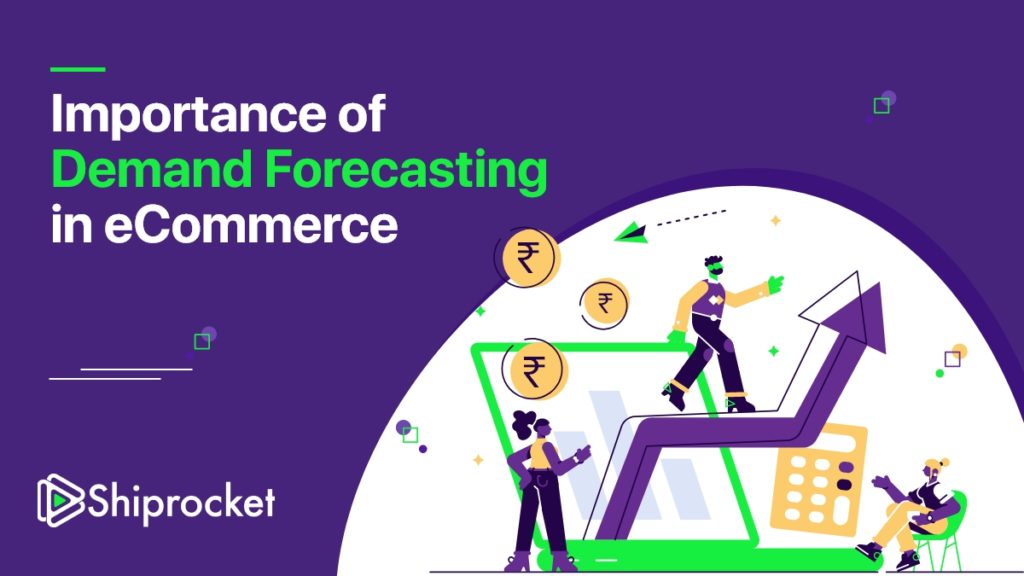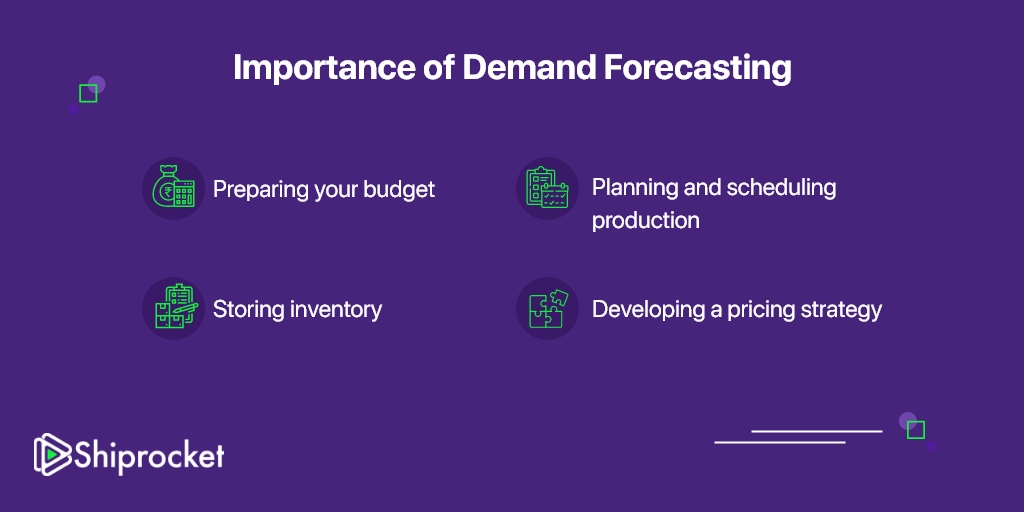Why Should Businesses Forecast Customer Demand?
Running a business is hard. You never really know how it will all turn out, yet you need to be able to answer questions like these:
How many inventory units do you need to have on hand to be at the entire stock for each SKU?
How often do you project to replenish inventory?
How will those projections change over time?
Where do you expect to be a year from now?

Okay, so maybe you only sort of have an understanding of the demand for your products. That’s fine! Forecasting projections is one of the most challenging things to get right.
And even when you’ve been doing it for a while and start to get the hang of it, your projections shift again.
Whether your brand is experiencing incremental sales or is in high-growth mode, we’ll walk you through some tips to improve your ability to forecast demand.
What is Demand Forecasting?
Demand forecasting is the process of predicting future sales by using historical sales data to make informed business decisions about everything from inventory planning and warehousing needs to running flash sales and meeting customer expectations. Demand forecasting helps the business estimate the total sales and revenue for a future period.
Importance of Demand Forecasting for eCommerce
Without demand, there is no business. And without a thorough understanding of demand, companies cannot be marketing decisions spend, production, staffing, and more.
Demand forecasting will never be 100% accurate. Still, you can take steps to improve production lead times, increase operational efficiencies, save money, launch new products, and provide a better customer experience.
Preparing Your Budget
Demand forecasting helps reduce risks and make efficient financial decisions that impact profit margins, cash flow, resource allocation, opportunities for expansion, inventory accounting, operating costs, staffing, and overall spend. All strategic and operational plans are formulated around forecasting demand.
Planning and Scheduling Production
Demand forecasting lets you provide the products your customers want when they want them. Forecasting demand requires that order fulfillment is synced up with your marketing before launching.
Nothing kills progress (or your reputation) faster than being sold out for weeks on end. Proper demand forecasting and inventory control can help ensure a business doesn’t buy insufficient or excessive inventory.
Storing Inventory
Demand forecasting can help you spend less money on both inventory purchase orders and warehousing, as the more inventory you carry, the more expensive it is to store. Good inventory management involves having enough product on hand but not too much.
Closely tracking inventory levels lets you easily restock and forecast inventory over time.
Developing a Pricing Strategy
Demand forecasting isn’t just about perfecting a business’s production schedule to supply demand, but it should also help price products based on the demand. Understanding the market and potential opportunities, companies can grow, formulate competitive pricing, employ the right marketing strategies, and invest in their growth.
If you choose to slash prices or put an item on promotion, demand may temporarily increase for that product. Without that sale, you may not have experienced the boost.
If there is a limited supply of a high-demand product, you can use the scarcity principle to increase the price as an exclusive offer. You must keep an eye on new entrants, though, as supply may increase.

Examples of Demand Forecasting
A small business may be on a conservative growth plan, while another company may be scaling or diversifying with aggressive growth plans. The demand forecasting examples below walk through a couple of different scenarios.
Example 1
A grocery store looks at sales trends from last year’s Thanksgiving week to prepare adequate inventory levels for the upcoming season. They look at sales leading into that week last year for seasonal products like turkeys, cranberries, and mashed potatoes.
It was a great holiday sale for them. But eight months ago, a competing grocery store opened four blocks away, so they’re unsure how Thanksgiving demand will be affected and if local customers will buy ingredients from their competitor.
At the same time, many families continue to move into the neighborhood, and they’ve still grown an average of 1% month-over-month since the competing chain opened.
They plan to launch a few more ads than last year through channels that have proven a good ROI for them in the past, and also offer some new deals to position themselves as the go-to Thanksgiving destination. Their calculations project a 5% increase in sales from last year.
Types of Demand Forecasting
There are various ways businesses can forecast demand. All forecasting models leverage data and analytics over specific periods of time.
Macro-Level
Macro-level demand forecasting looks at general economic conditions, external forces, and other broad things disrupting commerce. These factors keep a business in the know around portfolio expansion opportunities, market research intel, and different shifts in the market.
Micro-Level
Demand forecasting at the micro-level can be specific to a particular industry, business, or customer segment (e.g., examining demand for a natural deodorant for millennial customers in Chicago, IL).
Short-Term
Short-term demand forecasting is usually done for a time period of less than 12 months. It looks at demand for under a year of sales to inform the day-to-day (e.g., planning production needs for a Black Friday/Cyber Monday promotion).
Long-Term
Long-term demand forecasting is done for greater than a year. This helps identify and plan for seasonality, annual patterns, production capacity, and expansion over a more extended period. This drives long-term business strategy (e.g., plans to launch a facility or store internationally and expand into new markets).
Factors Influencing Customer Demand
Demand forecasting is where the supply chain side of business meets sales and marketing. Both sides must be in sync to succeed. Learn how different forces affect demand forecasting.
Seasonality
Seasonality refers to changes in order volume throughout a specific period. A highly seasonal brand may serve a particular period, event, or season, causing varying demand levels throughout the year including large spikes during their peak season (e.g., shoppers looking for grilling equipment right before the summer or 4th of July).
Competition
Competition affects demand as there are more options for your customers to choose from and more companies vying for their attention.
When a competitive force comes into play — whether it’s a direct competitor or a new kind of solution that forces your customer to choose between you or them — demand will be skewed. This can take you by surprise, so an agile demand forecasting model can help you respond quickly.
Types of Goods
Demand forecasting will be very different for different products and services — from perishable goods that expire quickly to subscription boxes that come simultaneously each month.
It’s essential to know the lifetime value of your customers (the total purchases they buy from you across channels over time), your average order value (how much they’re spending each time), and the combinations of products ordered to improve demand forecasting.
Using this data, you can understand how to group or bundle items, drive more recurring revenue, and see how one SKU affects or causes demand for another (e.g., razor and blade cartridge refill sales).
Geography
The geography of where your customers reside and where you manufacture and ship orders can significantly impact inventory forecasting and the speed at which you can fulfill customer orders.
The geographic locations of your supply chain can be very strategic. Using fulfillment centers in areas near your customers can help you fulfill customer demand quickly and more affordably, so it ships from the warehouse closest to the customer.
This helps you monitor where your customers reside and store certain products in the regions where they are ordered most, so you don’t have to ship to far away destinations.
How to Forecast Demand
Forecasting demand is a highly challenging task. You want to be flexible enough to handle sporadic influxes but also take a long-term approach. Here are some tips for your business.
1. Set objectives
Demand forecasting should have a clear purpose. At its core, it predicts what, how much, and when customers will purchase. Choose your time period, the specific product or general category you’re looking at, and whether you’re forecasting demand for everyone or a particular subset of people.
Ensure it satisfies your financial planners, product marketing, logistics, and operations teams in a non-biased way.
2. Collect and record data
Integrating all of the data from your sales channels can provide a cohesive view of actual product demand. Seeing the time and date of orders, SKU(s) ordered, and sales channel will help you forecast growth on a more granular level and look back to see how your forecasts matched up to reality.
You should also pay close attention to ecommerce returns, which can be costly. Products with high return rates should be evaluated and adjusted based on the reasons for returns. If 10% of items are being returned, and you’re able to decrease that number, your production may need to be adjusted as well.
In addition to your historical sales data, you may also need to pull in other pieces of data like market conditions. To ensure reliability and accuracy, data must be adequately prepared.
3. Measure and analyze data
Whether done manually or using automation and predictive analytics, you’ll need a repeatable data analysis process. This requires comparing what you predicted to actual sales to help you adapt your next forecast.
The chart below shows four different ShipBob customers on the same timeline that have all shipped 60,000 total orders in the same year. Measuring this helps track demand for various products at different times. While they each ship an average of 5,000 orders per month, some months are much lighter than others.
If the brands under-forecasted this volume, they wouldn’t have had enough inventory to ship orders out, and there wouldn’t be enough staff to fulfill them all in a timely manner. If they over-forecasted the volume, they would have spent a lot of money on inventory that is just sitting and taking much longer than anticipated to generate revenue.
As you grow, you may find you need to start tracking additional pieces of information such as obsolete stock, frequency of stockouts, and other order details you may need to improve.
4. Budget accordingly
Once you have a feedback loop, you can set your next forecast (hopefully more accurately) and update your budget to allocate funds where they should go based on growth goals. Demand forecasting helps you reduce inventory carrying costs, plan marketing spend, future headcount, production and inventory needs, and even new products.
Conclusion
Demand forecasting helps businesses make informed decisions that affect everything from inventory planning to supply chain optimization. With customer expectations changing faster than ever, businesses need a method to forecast demand accurately.





